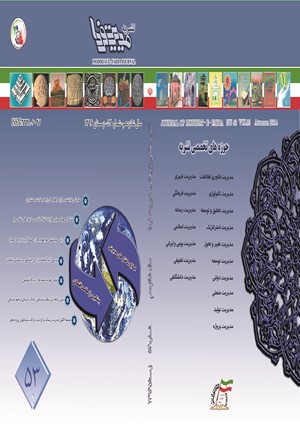The effect of exchange rate fluctuations on financial and physical flow in a global supply chain
Subject Areas :عطیه یوسفی 1 , mir saman pishvaee 2
1 -
2 - Iran University of Science and Technology
Keywords: Financial Flow Cash Flow Global Supply Chain Supply Chain Management Exchange Rates Fluctuations.,
Abstract :
A direct impact of financial resources on how to make decisions in all levels has led to modeling and optimizing financial flows in supply chains in last years. Also, considering the development of global markets and the move of companies towards globalization, the study of financial factors in this area has importance. The purpose of this research is to develop a MILP model with simultaneous focusing on financial and physical flows in a global supply chain. The main innovation of this research is the financial and physical flow integrated optimization in a global chain, which so far has not been studied in the financial literature. In this study, the effect of exchange rate fluctuations on financial variables and a total profit of the chain has been investigated. to show the model's efficiency, a sample problem and random data are used. The results indicate that an increasing exchange rate by 0.1 unit, will increase about six percentage of profit. Also, the exchange rate fluctuations cause significant changes in financial factors.
Altman, E. I. (1968). Financial ratios, discriminant analysis and the prediction of corporate
bankruptcy. The Journal of Financial.#
Bertel, s., Fenies, P., Roux, O. (2008). Optimal cash flow and operational planning in a
company supply chain. International Journal of Computer Integrated Manufacturing, 21(4), 440 -454.#
Comelli, Mickael., Pierre Fe´nie` s, Nikolay Tchernev. (2008). A combined financial and
physical flows evaluation for logistic process and tactical production planning: Application in a company supply chain. Int. J. Production Economics, 112(1), 77-95.
Chauffour, J.P., Malouche, M. (2011). Trade Finance during the Great Trade
Collapse.Washington DC: The World Bank.
Gereffi, G., Lee, J. (2012) Why the world suddenly cares about global supply chains.J. Supply
Chain Manage. http://dx.doi.org/10.1111/j.1745-493X.2012.03271.x.
Gupta, Sushil., Dutta, Kaushik. (2011). Modeling of financial supply chain. European Journal
of Operational Research, 211(1), 47-56.
Guill´en, Gonzalo., Badell, Mariana., Espu˜na, Antonio., Puigjaner, Luis. (2006).
Simultaneous optimization of process operations and financial decisions to enhance the integrated planning/scheduling of chemical supply chains. Computers and Chemical Engineering 30 (3) 421–436.
Hasani, Aliakbar., Khosrojerdi, Amirhossein. (2016). Robust global supply chain network
Design under disruption and uncertainty considering resilience strategies: A parallel memetic algorithm for a real-life case study. Transportation Research Part E, 87, 20–52.
Harvey, M.G., Richey, R.G. (2001). Global supply chain management: the selection of globally
competent managers. Journal of International Management, 7(2), 105-128
Hammami, R., Frein, Y., Hadj-Alouane, A.B. (2009). A strategic-tactical model for the supply
chain design in the delocalization context: mathematical formulation and a case study. International Journal of Production Economics, 122(1), 351-365
Hugo, A., Pistikopoulos, E.N. (2005). Environmentally conscious long-range planning and
design of supply chain networks. Journal of Cleaner Production, 13(15), 1471-1491.
Longinidis, Pantelis. Georgiadis, Michael C. (2013). Managing the trade-offs between
financial performance and credit solvency in the optimal design of supply chain networks under economic uncertainty. Computers and Chemical Engineering, 48(10), 264-279.
Longinidis, Pantelis., Georgiadis, Michael C. (2011). Integration of financial statement
analysis in the optimal design of supply chain networks under demand uncertainty. International Journal of Production Economics, 129(2), 262-276.
Masoud, Sherif A., Mason, Scott J. (2015). Integrated Cost Optimization in a Two-Stage,
Automotive Supply Chain. Computers and Operation Research, 67, 1-11.
Melo, M.T., Nickel, S., Saldanha da Gama, F. (2005). Dynamic multi commodity capacitated
facility location a mathematical modeling framework for strategic supply chain planning. Computers & Operations Research, 33(1), 181-208.
Neiro, Sérgio. M.S., Pinto, José. M. (2004). A general modeling framework for the operational
planning of petroleum supply chains. Computers & Chemical Engineering, 28(7), 871-896.
Nickel, Stefan., Saldanha-da-Gama, Francisco., Ziegler, Hans-Peter. (2012). A multi-stage
stochastic supply network design problem with financial decisions and risk management. Omega, 40(5), 512-524.
Naraharisetti, P.K., Karimi, I.A., Srinivasan, R. (2008). Supply chain redesign through optimal
asset management and capital budgeting. Computers and Chemical Engineering, 32(12), 3153-3169.
Protopappa-Sieke, Margarita., Ralf W. Seifert. (2010). Interrelating operational and financial
performance measurements in inventory control. European Journal of Operational Research, 204(3), 439-448.
Ramezani, Majid., Kimiagari, Ali Mohammad., Karimi, Behrooz. (2014). Closed-loop supply
chain network design: A financial approach. Applied Mathematical Modelling, 38(16), 4099-4119.
Stewart, G. B., III. EVATM: Fact and fantasy. (1994). Journal of Applied Corporate Finance.
Sabri, H., & Benita, M. (2000). A multi objective approach to simultaneous sterategic and
operational planning in supply chain design. Omega, 28, 581-598.
Vidal, Carlos. J., Goetschalckx, Marc. (2001). A global supply chain model with transfer
pricing a transportation cost allocation. European Journal of Operational Research, 129, 134-158.
Wang, F., Lai, X., Shi, N. (2011). A multi-objective optimization for green supply chain
network design. Decision Support Systems, 51(2),262-269.
Wang, Q., Batta, R., Bhadury, J., Rump, C.M. (2003). Budget constrained location problem
with opening and closing of facilities. Computers & Operations Research, 30(13), 2047-2069.
Wilhelm, Wilbert., Liang, Dong., Rao, Brijesh., Warrier, Deepak., Zhu, Xiaoyan., Bulusu,
Sharath. (2005). Design of international assembly systems and their supply chains under NAFTA. Transportation Research Part E, 41(6), 467-493.
تاثیر عوامل کلان اقتصادی بر نماگر بازار سهام، فصلنامه تازه¬های اقتصاد، شماره 139، بهار 1392.#
محمدپرست طبس، حوا (1390). بررسي تأثیر نوسانات نرخ ارز واقعي بر شاخص¬هاي کلان اقتصادي (تولید، تورم و عرضه پول). پایان¬نامه کارشناسی ارشد علوم اقتصادی، دانشگاه آزاد اسلامي واحد تهران مرکزي.#


